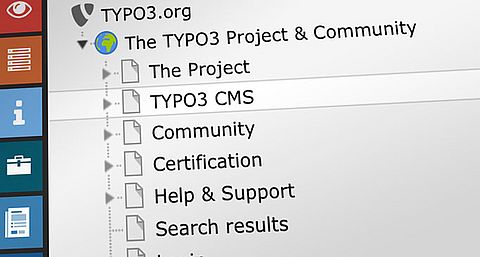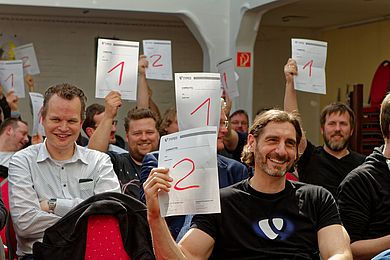Over the last years TYPO3 CMS has gone through a lot of drastic changes. These changes were necessary to build a solid foundation for the future development and to pave the way for the next generation of TYPO3 CMS.
During the TYPO3 CMS Active Contributor Meeting in September 2014, the decision for a next release was made together with a new working mode and a shift of focus on what to improve - the experience for editors, the every-day users of TYPO3 CMS.
Additionally, the release policy is changing to progress with a more agile and efficient release cycle.
About releases
The current strategy for releasing every six months with certain releases marked as Long Term Support (LTS) had shown certain drawbacks in the recent past. One major aspect was that the intermediate releases with new features between the LTS versions didn't show enough adoption in order to support them for 18 months - resulting in a lot of intermediate releases that needed bugfixes, backports etc. Additionally, an LTS release every three years seems to be a long time for people to upgrade their installations waiting for new features - as it is way too much to consider technically when upgrading. However, having LTS releases in general has shown great appreciation throughout customers, extension authors and the community. The next LTS is therefore scheduled for fall 2015.
The next release iteration towards the coming LTS will have regular releases with a better migration strategy striving for a smooth migration during upgrades. So the next release will be called 7.0 and be released in November 2014. It will contain a lot of cleanups and minor improvements already made in the past months. From there on you can expect a new version to be released every few months or even weeks - each of these will focus on a certain goal which has been prioritized based on feedback from the community and the assessment of the Active Contributors.
Every release is based on the proven workflow of a merge window which is then followed by a stabilization phase - very much like the “big” releases you know now, just scaled down to be quicker.
At a certain point around fall 2015 the release manager will define when the current status is ready to be tagged as a LTS release.
From here on out it will be handled just like any other LTS release we had in the past with a full three years of support on security fixes and critical bugfixes.
Once 7 LTS is released, we will kick off the CMS 8 branch with the same release strategy so we can work in a faster way and get more improvements on the road quicker.
We will of course continue to publish maintenance releases for the currently supported TYPO3 versions, namely 6.2 LTS and 4.5 LTS at the same date, which will always happen on tuesdays, having 4-8 week time windows between the releases in order to give you a more regular release schedule for your running projects.

What can you expect of CMS7 LTS?
Now as the codewise groundwork has been laid with CMS 6.0 - 6.2 LTS, we can finally shift our main focus towards a better user experience for editors, a leaner and more flexible code base and optimized best practices for setting up websites.
So basically the main goals of CMS7 can be boiled down to:
- better user experience for editors
- lean core
- strong defaults
We do realize that these goals might seem a little vague at first but this is because they shall apply to TYPO3 CMS as a whole - not just necessarily to CMS7 in detail.
These are just the goals we focus on the most for now.
So let’s get into more detail, shall we?
Usability improvements for the TYPO3 Backend
Huge parts of the backend will be rebuilt from the ground up using Twitter Bootstrap.
Doing so will enable us to implement a lot of usability improvements more rapidly. We get rid of a lot of legacy code that is hard to maintain and might even break on more modern browsers. Besides that we also support integrators by supplying a great layout base to build their extensions upon and now offer a lot of nifty little features you can use within your backend modules or apps, as we will call them from now on.
And if all this wasn’t enough you have the full set of tools at your hands to skin the backend using LESS.
Performance for the TYPO3 Backend
Through the streamlining of the interface comes a lot of improvements under the hood in order to use the right technology for the right way. The mixture of PHP, HTML and CSS for styling is replaced, most of the JS code is simplified, and of course, a lot of PHP code is streamlined to also improve performance when navigating through the TYPO3 backend.
Strong defaults
If you followed our recent communication a bit you might have come across the term “strong defaults”. What we mean by this is that we will dramatically streamline the amount of options how you can achieve things with TYPO3 CMS. Strong defaults will incorporate best practices we've learned over the last decade in order to help you set up your TYPO3 CMS website faster and more efficient than before.
Optimized Frontend output and content element handling
As you know the challenges when creating websites change constantly. This is why we are improving the standard output of TYPO3 CMS regularly to comply with the latest development. Also we will streamline the way you work with content elements during your daily work with TYPO3 CMS.
Getting closer to handling extensions as composer packages natively
Composer is the baseline of package handling. If you are focussed on TYPO3 CMS you might use the term “extension” - although what you really mean is a package.
Since Composer offers a strong and reliable basis and ecosystem for package handling within the PHP world it is a no-brainer to work towards a full implementation of Composer inside the TYPO3 CMS core.
But as you are used to from TYPO3 CMS there will be a very intuitive and accessible way of dealing with packages/extensions and their dependencies - stay tuned for more.
More automation in several places of the TYPO3 CMS core
A lot of things can be done with the TYPO3 install tool and the TYPO3 backend, but the command line interface lacks a unified way to deal with certain day-to-day tasks of administrators. A lot more automatic lookups for package code can be achieved for extension developers to make their extensions more standardized.
As you can see the CMS 7 development process focuses on continuous innovation in small steps instead of big features rolling in just before the end of 7 LTS development cycle that might result in bigger problems just before the final LTS release that would confront you with huge challenges all at once.
Instead, we will deliver smaller iterations one by one so that you can grow with the system step by step.
What does it mean for you?
As an
extension developer you can check your extensions already for compatibility throughout the process and can safely make sure that your extension still runs with CMS 6.2 LTS and work towards a compatibility release for CMS 7 LTS.
As an
integrator you will be amazed by the way you can set up sites easier and quicker than ever before.
As an
editor or
administrator you will get a lot of streamlined UI components that help you make your daily work faster and simply more fun.
As an
agency you can expect to have another LTS version coming up in one year with a leaner upgrade process and a lot of benefits that you can tell sell to your customers.
Stay tuned for the next releases, we can't wait to give you an even better CMS version soon!
Contact me (<link>benni@typo3.org) if you have any questions.
You can also get in touch with the CMS team on <link http: forum.typo3.org index.php f>
forum.typo3.org/index.php/f/18/ and of course the TYPO3 CMS issue tracker accepts issues 24/7 here: <link https: forge.typo3.org projects typo3cms-core>
forge.typo3.org/projects/typo3cms-core





